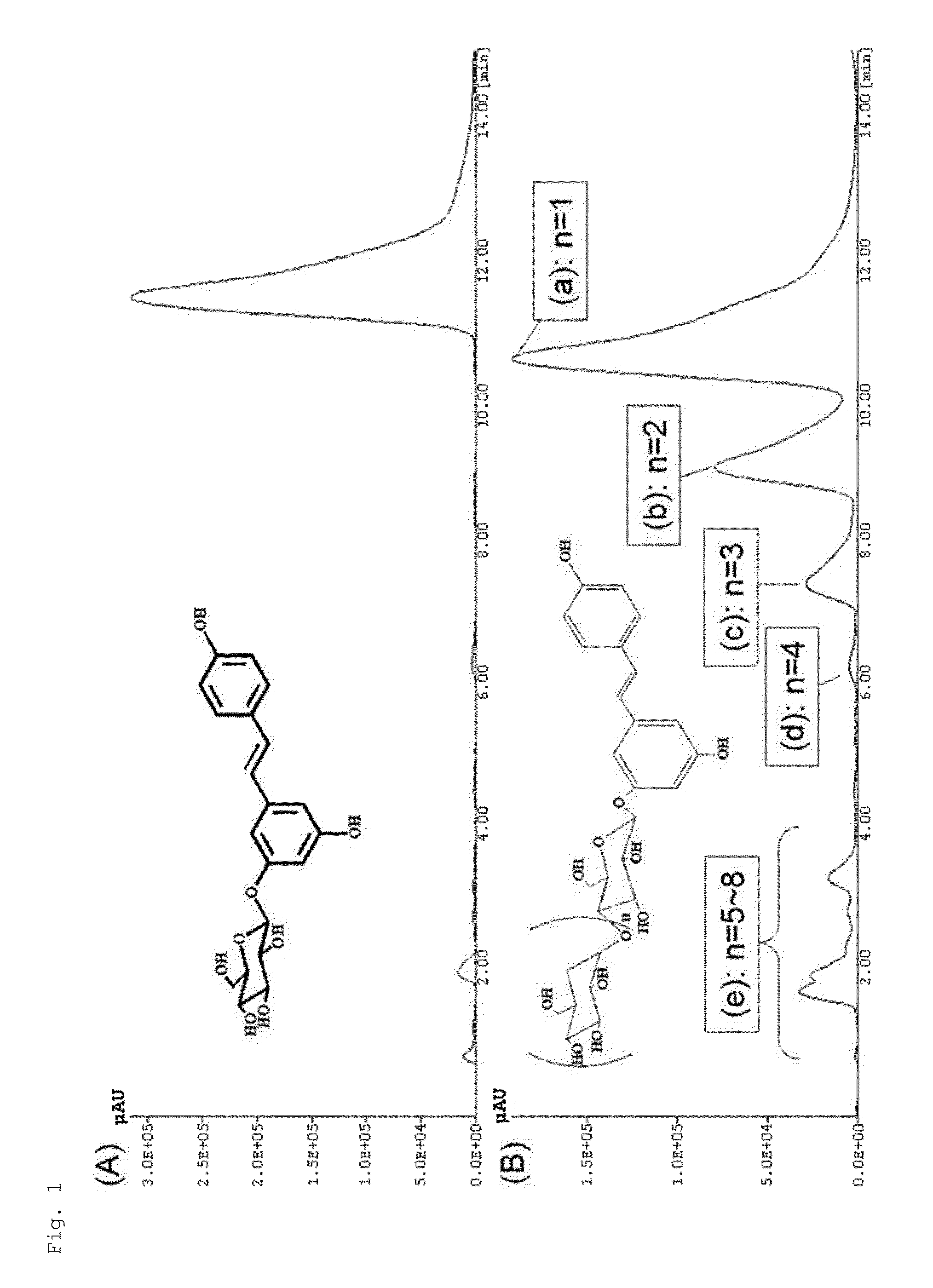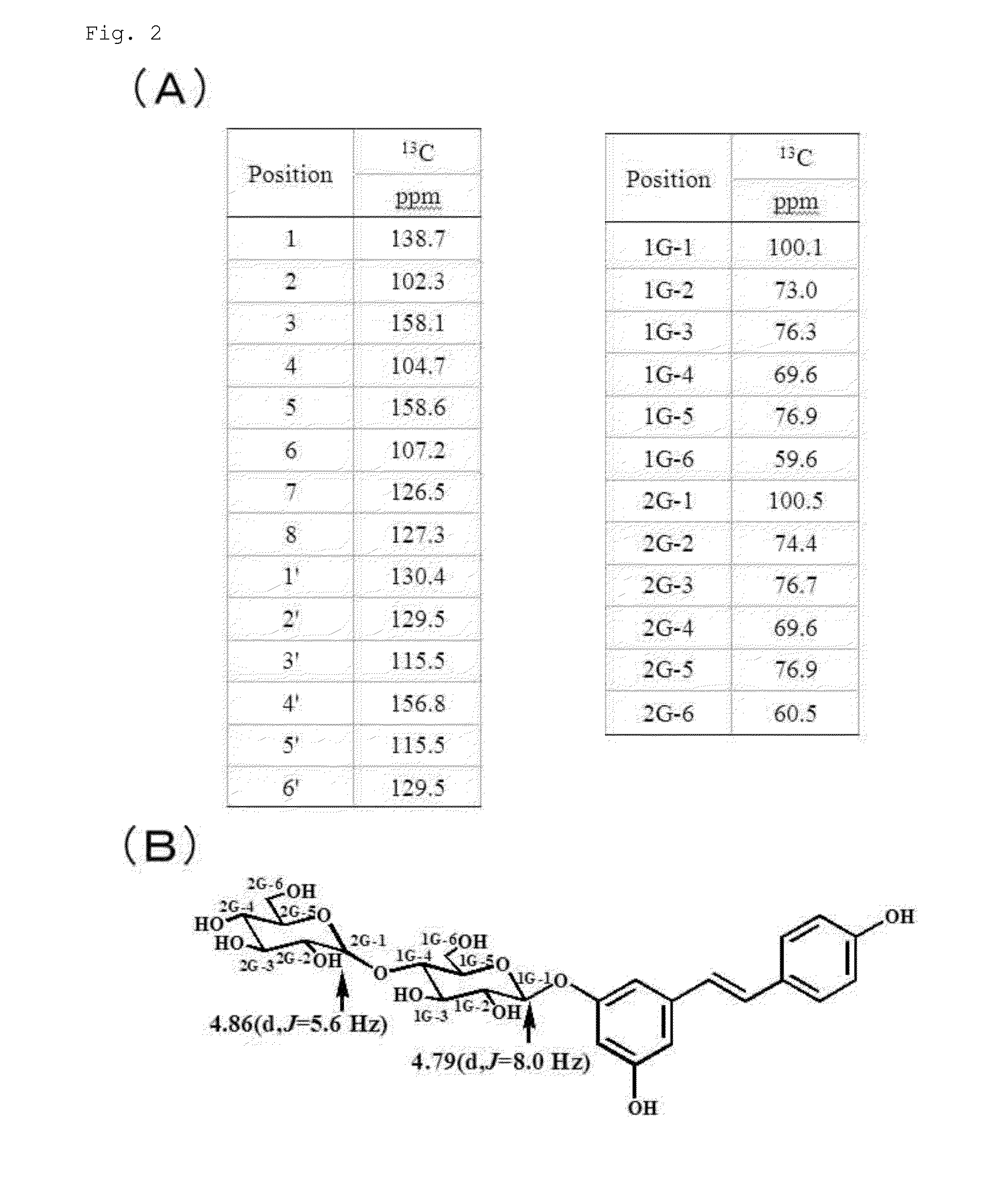Trans-resveratrol polysaccharide, method for producing the same, and composition comprising the same
a technology of transresveratrol and polysaccharide, which is applied in the field of transresveratrol polysaccharide, can solve the problems of poorly soluble resveratrol in water, and achieve the effects of high water soluble, easy to be taken into cells, and easy isomerization
- Summary
- Abstract
- Description
- Claims
- Application Information
AI Technical Summary
Benefits of technology
Problems solved by technology
Method used
Image
Examples
production example 1
[0151]400 mg of trans-resveratrol-3-O-β-D-monoglucoside, 4 g of α-cyclodextrin, and 25 mL of Cyclodextrin glucanotransferase “Amano” (600 units / mL; Amano Enzyme Inc.) were added to 300 mL of citric acid-sodium citrate buffer (pH of 5.4), and the mixture was stirred by a magnetic stirrer in a hot-water bath at 55° C. for 24 hours to perform enzyme reaction.
[0152]Subsequently, the reaction solution was heated to 80° C. in a hot-water bath to inactivate the Cyclodextrin glucanotransferase “Amano”. The reaction solution was then cooled to ordinary temperature, and partition extraction with ethyl acetate / water was performed six times. The obtained oil phase fraction was subjected to salting-out, dehydration, and a vacuum concentration process, and sampled by HPLC using a CrestPak C18S column (JASCO; 4.6×150).
[0153]The aqueous phase fraction obtained by partition extraction with ethyl acetate was further subjected to partition extraction with water-saturated n-butanol three times, and the...
production example 2
[0164]Moreover, the starting material in Production Example 1 was changed from trans-resveratrol-3-monoglucoside to trans-resveratrol-4′-monoglucoside, and the same experiment was performed. FIG. 3 shows the results of the NMR measurement of a fraction with a peak indicating a polysaccharide with 2 sugars, fractionated by HPLC.
[0165]From the results shown in FIG. 3 (A), trans-resveratrol-4′-O-β-D-diglucoside shown in FIG. 3 (B) was identified.
[0166]In a column chromatography experiment the same as in Production Example 1, cis-resveratrol was also not detected.
example 1
[0182]The aqueous phase fraction after phase separation with ethyl acetate / water obtained in Production Example 1 (see FIG. 1 (B)) was subjected to heat treatment at 80° C. overnight. The samples before and after treatment were subjected to column chromatography in the same manner as described above. FIG. 8 shows the results.
[0183]When the column chromatography results were compared before and after heat treatment, no change was observed in the chart pattern. In consideration of the tendency of cis-resveratrol to show a longer retention time, as described above, it was revealed that the above trans-resveratrol polysaccharides (glycosides with 2 or more sugars) resisted isomerization to the cis-form by heat treatment, and were stable as the trans-form.
[0184]This suggests that trans-resveratrol polysaccharides are not isomerized to the cis-form by the action of ultraviolet radiation, acid, base, etc., other than heat treatment. Trans-resveratrol polysaccharides that can withstand such...
PUM
| Property | Measurement | Unit |
|---|---|---|
| length | aaaaa | aaaaa |
| molar ratio | aaaaa | aaaaa |
| molar ratio | aaaaa | aaaaa |
Abstract
Description
Claims
Application Information
 Login to View More
Login to View More - R&D
- Intellectual Property
- Life Sciences
- Materials
- Tech Scout
- Unparalleled Data Quality
- Higher Quality Content
- 60% Fewer Hallucinations
Browse by: Latest US Patents, China's latest patents, Technical Efficacy Thesaurus, Application Domain, Technology Topic, Popular Technical Reports.
© 2025 PatSnap. All rights reserved.Legal|Privacy policy|Modern Slavery Act Transparency Statement|Sitemap|About US| Contact US: help@patsnap.com



